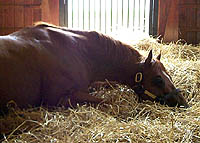2001 KY Livestock Outlook Strong
2001 KY Livestock Outlook Strong

Sales of horses and mules, including stud fees, in the Commonwealth were up nearly 25 percent and likely topped $1 billion for the first time in 2000, making equine the largest enterprise in Kentucky. Agricultural economic specialists at the University of Kentucky agree the outlook for equine and other livestock in 2001 is strong and will build on successes of 1999 and 2000.
"Horses account for about 25 percent of all farm receipts in Kentucky, said Larry Jones, UK agricultural economist. "In fact, about 29 percent of horse sales in the United States are concentrated in five counties around Lexington. It's not to suggest that the industry is not vitally important to the state, because I think it is in many ways. But the direct effects tend to be in those five counties (Fayette, Scott, Bourbon, Woodford and Jessamine)."
Kentucky ranks first in the nation in Thoroughbred sales. Jones said receipts for the horse industry were due, in part, to significantly higher prices for Thoroughbreds at Keeneland. Limited data makes it hard to predict the future of the industry. There is not much information available beyond Keeneland and estimates from Kentucky Agricultural Statistics.
Jones mentioned that the horse industry is subject to many of the same variables that impact other segments of agriculture including interest rates, export conditions, energy prices, as well as the supply of horses. Supplies have been on the rise and are expected to continue rising in 2001 while the demand for Thoroughbreds remains relatively strong.
Thoroughbred prices should rise, but at a slower rate, due to a slowing U.S. economy and a strong U.S. dollar. Cash receipts are expected to exceed $1.14 billion, keeping the equine sector Kentucky's largest agricultural enterprise.
In other livestock areas, positive growth is expected in 2001. Demand for red meat continues to be strong.
"It's encouraging that the demand for beef has increased for the first time in 25 years," said Lee Meyer, UK Agricultural Economist. He said that demand coupled with continually higher cattle prices over the next year, will benefit Kentucky's beef producers, but warned that producers still need to be mindful of the cattle cycle and feed production, since strong feeder prices depend on inexpensive feed prices. If corn prices suddenly jump, feedlots will lower their bids for calves.
Meyer said to watch for a drop in feedlot placements, an increase in fed cattle prices, a decline in beef production and an increase in heifer retention. He also said to expect three to four years of profitable calf prices.
Hog producers saw a 35 percent increase in 2000 prices over 1999 prices, which moved the industry from bankruptcy to profitable status. In 2001, Kentucky could see an increase in hog production, pending expansion of the hog market. Producers should see strong demand for their product and a year of profits, continued with cheap feed.
In the poultry industry, Meyer said broiler income increased 80 percent in 1998, then an additional 10 percent in 1999. He expects small increases again in income as well as production numbers. Broiler prices were down three percent in 2000, but are expected to remain steady in 2001.
Overall, 2001 looks to be a good year for Kentucky livestock producers.
